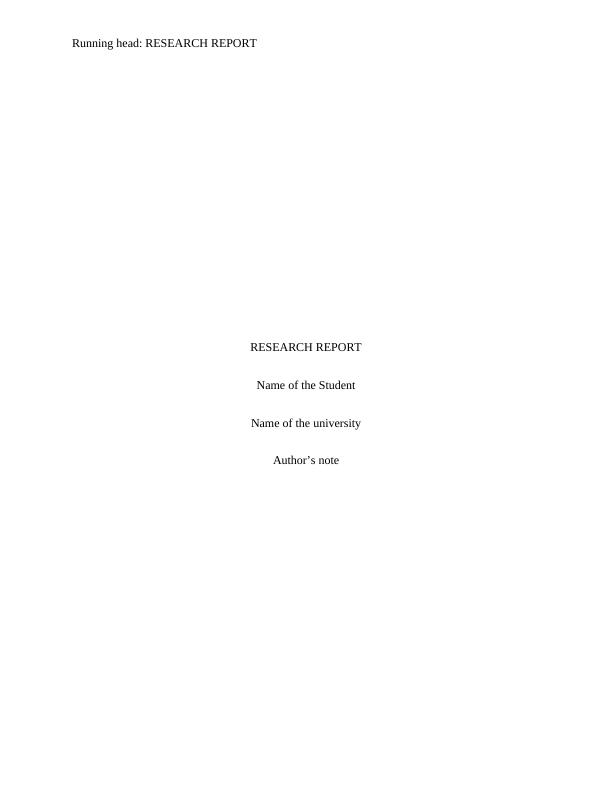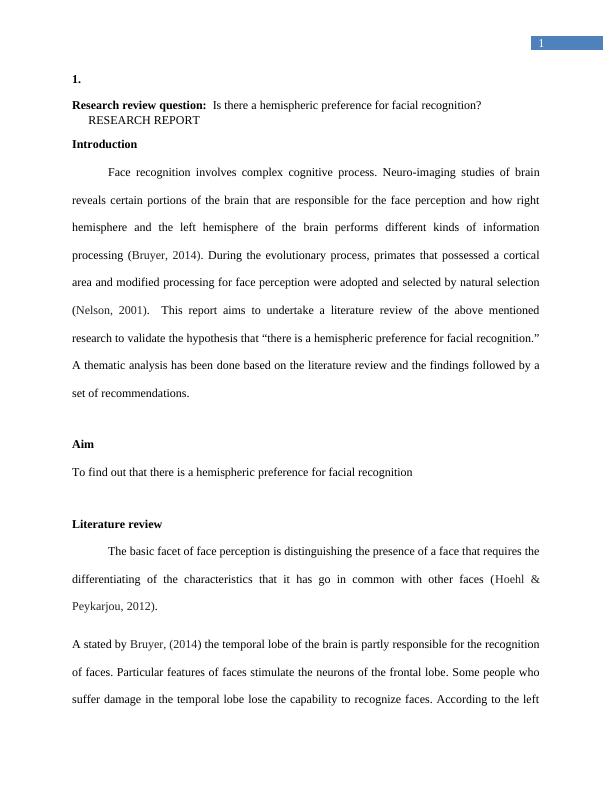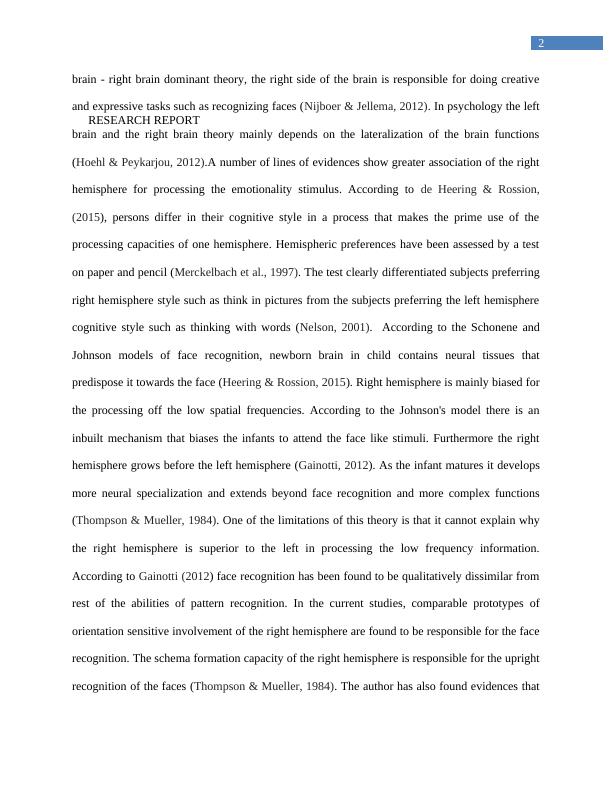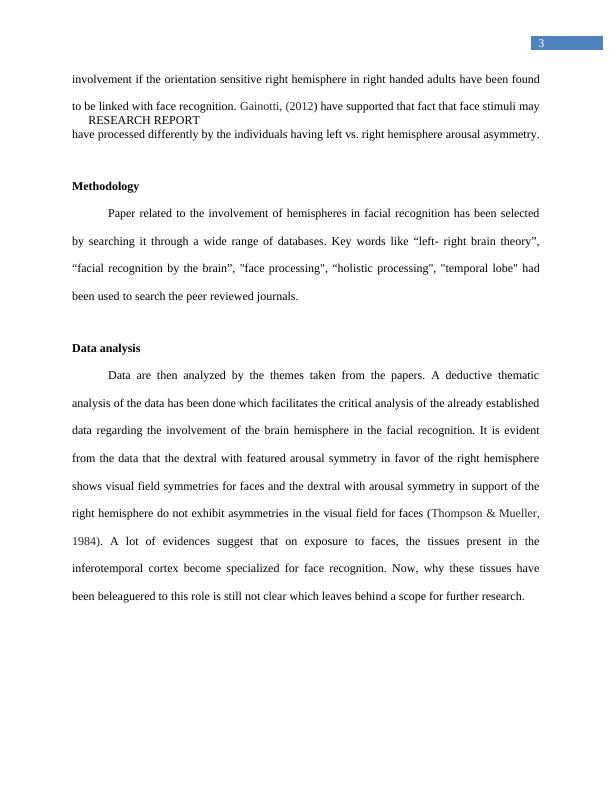Ask a question from expert
Literature Review Assignment: Facial Recognition
11 Pages2419 Words296 Views
Added on 2020-05-28
Literature Review Assignment: Facial Recognition
Added on 2020-05-28
BookmarkShareRelated Documents
Running head: RESEARCH REPORTRESEARCH REPORTName of the StudentName of the universityAuthor’s note

1RESEARCH REPORT1. Research review question: Is there a hemispheric preference for facial recognition? IntroductionFace recognition involves complex cognitive process. Neuro-imaging studies of brainreveals certain portions of the brain that are responsible for the face perception and how righthemisphere and the left hemisphere of the brain performs different kinds of informationprocessing (Bruyer, 2014). During the evolutionary process, primates that possessed a corticalarea and modified processing for face perception were adopted and selected by natural selection(Nelson, 2001). This report aims to undertake a literature review of the above mentionedresearch to validate the hypothesis that “there is a hemispheric preference for facial recognition.”A thematic analysis has been done based on the literature review and the findings followed by aset of recommendations.AimTo find out that there is a hemispheric preference for facial recognitionLiterature reviewThe basic facet of face perception is distinguishing the presence of a face that requires thedifferentiating of the characteristics that it has go in common with other faces (Hoehl &Peykarjou, 2012).A stated by Bruyer, (2014) the temporal lobe of the brain is partly responsible for the recognitionof faces. Particular features of faces stimulate the neurons of the frontal lobe. Some people whosuffer damage in the temporal lobe lose the capability to recognize faces. According to the left

2RESEARCH REPORTbrain - right brain dominant theory, the right side of the brain is responsible for doing creativeand expressive tasks such as recognizing faces (Nijboer & Jellema, 2012). In psychology the leftbrain and the right brain theory mainly depends on the lateralization of the brain functions(Hoehl & Peykarjou, 2012).A number of lines of evidences show greater association of the righthemisphere for processing the emotionality stimulus. According to de Heering & Rossion,(2015), persons differ in their cognitive style in a process that makes the prime use of theprocessing capacities of one hemisphere. Hemispheric preferences have been assessed by a teston paper and pencil (Merckelbach et al., 1997). The test clearly differentiated subjects preferringright hemisphere style such as think in pictures from the subjects preferring the left hemispherecognitive style such as thinking with words (Nelson, 2001). According to the Schonene andJohnson models of face recognition, newborn brain in child contains neural tissues thatpredispose it towards the face (Heering & Rossion, 2015). Right hemisphere is mainly biased forthe processing off the low spatial frequencies. According to the Johnson's model there is aninbuilt mechanism that biases the infants to attend the face like stimuli. Furthermore the righthemisphere grows before the left hemisphere (Gainotti, 2012). As the infant matures it developsmore neural specialization and extends beyond face recognition and more complex functions(Thompson & Mueller, 1984). One of the limitations of this theory is that it cannot explain whythe right hemisphere is superior to the left in processing the low frequency information.According to Gainotti (2012) face recognition has been found to be qualitatively dissimilar fromrest of the abilities of pattern recognition. In the current studies, comparable prototypes oforientation sensitive involvement of the right hemisphere are found to be responsible for the facerecognition. The schema formation capacity of the right hemisphere is responsible for the uprightrecognition of the faces (Thompson & Mueller, 1984). The author has also found evidences that

3RESEARCH REPORTinvolvement if the orientation sensitive right hemisphere in right handed adults have been foundto be linked with face recognition. Gainotti, (2012) have supported that fact that face stimuli mayhave processed differently by the individuals having left vs. right hemisphere arousal asymmetry.MethodologyPaper related to the involvement of hemispheres in facial recognition has been selectedby searching it through a wide range of databases. Key words like “left- right brain theory”,“facial recognition by the brain”, "face processing", “holistic processing", "temporal lobe" hadbeen used to search the peer reviewed journals. Data analysisData are then analyzed by the themes taken from the papers. A deductive thematicanalysis of the data has been done which facilitates the critical analysis of the already establisheddata regarding the involvement of the brain hemisphere in the facial recognition. It is evidentfrom the data that the dextral with featured arousal symmetry in favor of the right hemisphereshows visual field symmetries for faces and the dextral with arousal symmetry in support of theright hemisphere do not exhibit asymmetries in the visual field for faces (Thompson & Mueller,1984). A lot of evidences suggest that on exposure to faces, the tissues present in theinferotemporal cortex become specialized for face recognition. Now, why these tissues havebeen beleaguered to this role is still not clear which leaves behind a scope for further research.

End of preview
Want to access all the pages? Upload your documents or become a member.